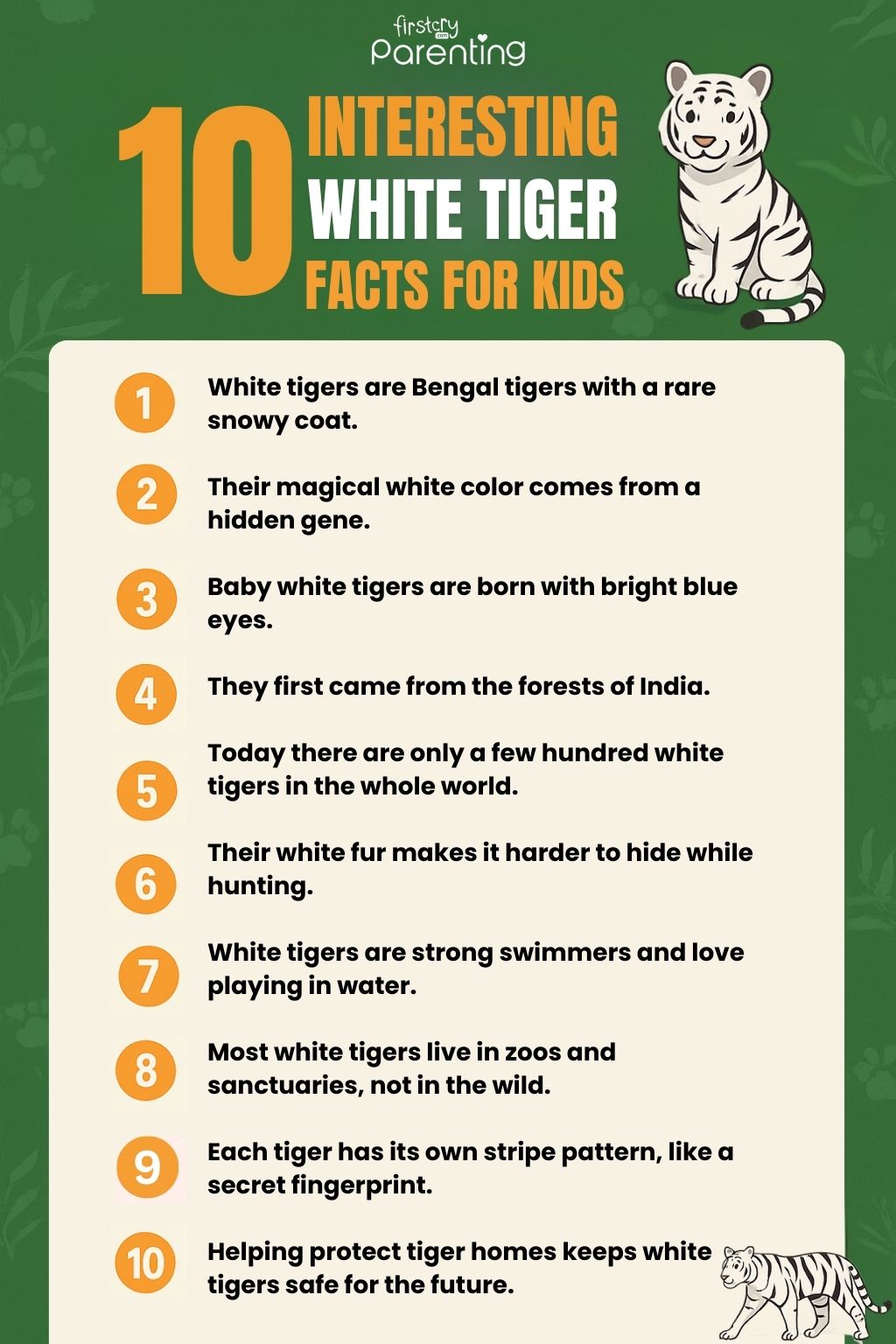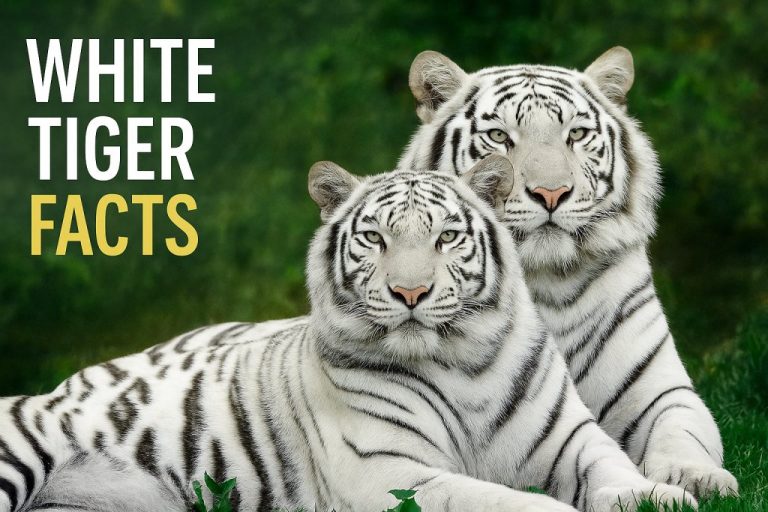40+ Interesting White Tiger Facts for Kids
- White Tiger Lifespan and Appearance
- White Tiger Behaviour and Lifestyle
- Reproduction of White Tiger
- White Tiger Diet
- White Tiger Habitat
- Other Fun Facts About White Tiger for Children
- FAQs
- Infographic: 10 Interesting White Tiger Facts for Kids
Children usually bond with household pets, residents at a petting zoo, classroom pets, and even the neighbourhood cat, as these creatures spark a lifelong love of animals. However, encounters with wild animals can be extra special and become a child’s treasured memory, especially with the magnificent white tiger characteristics. Seeing wild animals in their natural habitat opens up a whole new world of wonder, making them curious about their appearance, behaviour, lifestyle, and environment. Begin their journey of wonder with the fascinating white tiger facts for kids. These amazing white tiger facts and information for preschoolers will open up a whole new world of knowledge for your curious child!
White Tiger Lifespan and Appearance
The fascinating appearance of white tigers makes them look like mythical creatures. Here is some white tiger information about their appearance and lifespan.
- A subspecies of tigers, the white tiger is the pigmented variation of the Bengal Tiger.
- All white tigers have blue eyes with round pupils. Their eyes can also be green and amber in colour.
- Due to their white coat, they are often referred to as bleached tigers. The colour results from the genetic mutations that are part of their natural species diversity.
- The absence of pheomelanin, a pigment found in the normal orange tigers, results in white fur.
- It has grey and light brown stripes on a light cream-colored coat.
- Its distinctive coat pattern with stripes is like fingerprints, with no two tigers having the same pattern.
- As the white-and-black colour of white tigers makes them stand out from their surroundings, they often fall prey to other carnivores or hunters.
- They have white-coloured face fur and a rose-pink nose.
- White tigers typically reach full growth by 2-3 years.
- White tigers typically live for around 10 to 20 years in the wild.
- The weight of a White male tiger can be between 200 and 230 kilograms. They grow up to 9.8 ft. in length.
- The average length of a male white tiger is about 8-10.2 feet, while the female tiger measures between 7.1 and 8.5 feet.
- White tigers are bigger from birth and continue that pattern into their adult years.
- According to recent breeding records of 1,700 Bengal Tigers kept in Indian zoos, the mortality and longevity rates of orange and white tigers are the same.
White Tiger Behaviour and Lifestyle
White tigers are incredibly quick, agile, and very capable swimmers, allowing them to cross boundaries such as rivers and moats. However, they are very poor climbers. Some interesting facts about their behaviour and lifestyle:
- White tigers are crepuscular, meaning they hunt primarily at dawn and dusk.
- They stalk their prey at night by approaching it quietly and attacking it by surprise.
- The white tigers prefer to live in their territory, which covers a radius of 10-30 square miles.
- As white tigers are skilled swimmers, they can catch and kill their prey even while swimming.
- They sleep for about 16-18 hours per day.
- Their speed can go up to 50-60 km per hour.
- The male white tiger might share several female tigers’ territories for mating.
- White tigers are more muscular, stronger, and more aggressive than Orange Tigers.
Reproduction of White Tiger
Reproduction between white tigers is slightly different from how similar animals generally reproduce. Here are some fun facts:
- Specific recessive genes of two Bengal Tigers combine for a white tiger to be born.
- Male and female white tigers get attracted to one another by their roars and scent marks. A white tigress reaches sexual maturity in approximately 3 to 4 years.
- The gestation period of a White Tigress is for three and a half months, and approximately five cubs are born at a time.
- The cubs are incubated within her uterus and are nourished through the umbilical cords. They are born alive. The cubs are born in a secluded den that their mother has prepared for them.
- Crossbreeding Bengal tigers with Siberian tigers increases the odds of producing white cubs.
- All white tigers are inbred within the family members and are not purebred.
White Tiger Diet

White tigers are carnivores that eat only meat by hunting other animals. Some interesting facts about their diet:
- It mostly eats plant-eating herbivores found in the forest and its outskirts. Langur monkeys, goats, buffaloes, wild boars, and deer are some animals they usually kill.
- It can eat about 18kg of meat at one go and will hunt again after a few days of feasting.
- The diet of a Captive white tiger includes chicken, horse meat, or kangaroo meat.
- Due to their large size, they use their weight to throw down their prey and bite its neck to kill it. They have formidable and retractable claws that help to capture and hold on to their prey.
- In the case of the unavailability of herbivores, they may also hunt leopards, young wolves, young elephants, and rhinos.
White Tiger Habitat
White tigers in the jungle share their habitat with the orange Bengal Tigers. Some more interesting white tiger habitat facts are:
- Their habitat depends upon the animals they usually hunt and eat in the forest.
- Abundant food, water, and trees make up the best habitat for white tigers. The grassy areas and their stripes help give them some camouflage!
- Like all Bengal tigers, white tigers once lived in the wild in Asia, particularly in countries such as India. They now live in captivity, which helps to keep them protected.
- White tigers cannot survive in the snow.
- No known white tiger exists in the wild anymore. They are all found in captivity, primarily in zoos, circuses, rescue sanctuaries, and other facilities designated for animal display.
- White Tigers have no natural predators; humans hunt them for exotic skin colour, trophy hunting, traditional medicine, exotic pet trade, and habitat destruction.
Other Fun Facts About White Tiger for Children
Some fun facts about white tigers in detail:
- Besides the Bengal tiger, the white tiger is believed to be the world’s second-largest tiger species after the Siberian tiger.
- Uncontrolled trophy hunting, habitat loss, and habitat fragmentation are the primary reasons for the extinction of wild white tigers and the dramatic decline in wild tiger populations in general.
- White tigers have enzymes in their fur that react to temperature, causing them to grow darker in cold weather.
- The white tiger also holds cultural significance. It is one of the Four Symbols of the Chinese constellations. Also known as the White Tiger of the West, the animal is referred to as Baihu in Chinese, Byakko in Japanese, Baekho in Korean, and Bạch Hổ in Vietnamese. The white tiger represents the West in terms of direction and the autumn season.
- The earliest recorded existence of white tigers was put on display at the Exeter Exchange in London in 1820.
- The inbreeding of white tigers in strict captivity often causes certain genetic issues, like Down syndrome, scoliosis, cleft palates, mental impairments, and crossed eyes.
- Only 12 white tigers were seen in the wild throughout the twentieth century.
- White tigers are bred primarily for entertainment, rather than for conservation purposes. Thus, the American Zoological Association (AZA) believes that these cats should not be bred and directs AZA-accredited zoos against breeding.
FAQs
1. What makes a tiger a unique animal?
Tigers’ unique feature is the white spot located at the end of each ear. These spots look like eyes, creating the impression that the tiger is observing its surroundings. This may help the tiger evade potential threats.
2. How are tigers culturally and symbolically associated?
Throughout history, tigers have been admired in various cultures. In India, they represent grandeur, strength, and ferocity. They hold both a prestigious title as the national animal and a spiritual one as the chariot of Goddess Durga, an important deity in Hinduism. In Chinese culture, the tiger embodies masculine strength and is regarded as the ruler of the animal kingdom (1).
3. How can children take part in the protection of tigers?
Kids can play a role in tiger conservation by discovering interesting facts about these incredible creatures and sharing them with their peers. Engaging in activities like drawing tigers, writing stories, supporting conservation initiatives, and participating in campaigns to protect their habitats are wonderful ways to take action.
4. What does a tiger do for its survival?
The bold stripes of tigers are not only visually striking but also provide natural camouflage in the jungle. It’s not merely about aesthetics, but about blending into the environment to avoid detection by prey. They also rely on their excellent sense of hearing for survival. Tigers can perceive infrasound, which consists of low-frequency sounds that are inaudible to humans. This ability enables them to communicate over long distances, even through thick forests and rugged terrains, such as mountains. Thus, their stripes and keen hearing enhance their ability to adapt to survival (2).
We hope you learned a great deal from these white tiger animal facts. Teaching wildlife conservation through fun and interactive education can be a first step towards protecting the natural landscapes that wildlife needs to survive. The growing awareness of white tigers can make them more appreciative of the natural world and sensitive towards their friends and family. Many conservation biologists are trying to protect wildlife so that kids can live in a world where animals like white tigers still exist. Thus, learning about biodiversity and sharing what they know with their friends can enhance their emotional development and build their social skills.
Infographic: 10 Interesting White Tiger Facts for Kids

Image Source: AI-Generated Image
Also Read:
Cool Lion Facts for Kids
Fun Cheetah Facts for Children
Facts About Wolves for Kids
Interesting Zebra Facts for Children
Was This Article Helpful?
Parenting is a huge responsibility, for you as a caregiver, but also for us as a parenting content platform. We understand that and take our responsibility of creating credible content seriously. FirstCry Parenting articles are written and published only after extensive research using factually sound references to deliver quality content that is accurate, validated by experts, and completely reliable. To understand how we go about creating content that is credible, read our editorial policy here.























